Create a fantastic Ecommerce Website for your B2C, D2C and B2B Ecommerce business.
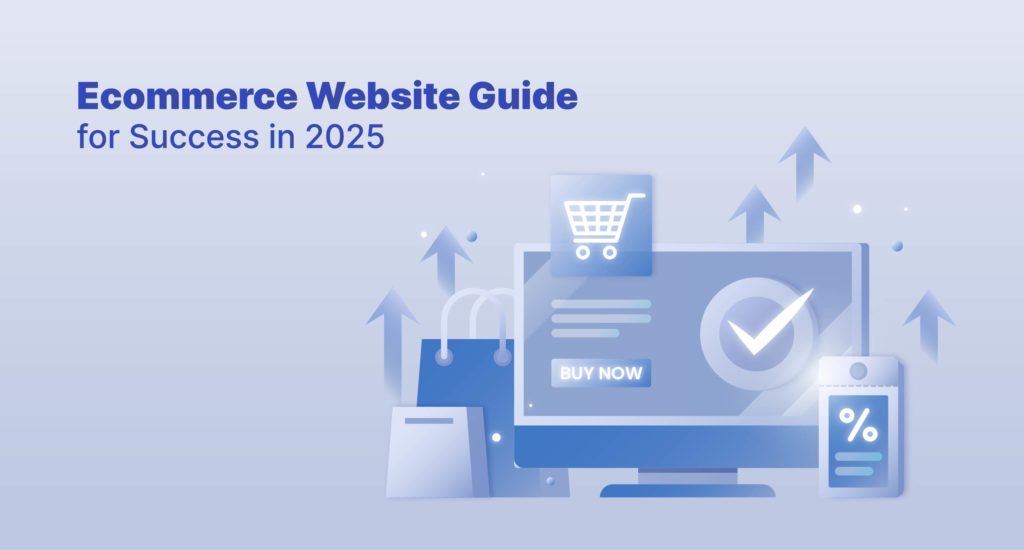
Thinking of launching your ecommerce website in 2025 but don’t know where to begin?
You’re not alone. In a market as dynamic as India’s, setting up an online store isn’t just about choosing a platform and uploading products. It’s about crafting a digital storefront that performs, ranks, and converts.
In our previous blog, we unpacked the fundamentals of ecommerce websites and explored key business models shaping the landscape—B2B ecommerce, B2C ecommerce, D2C, and Social ecommerce. We also examined why ecommerce is poised to dominate India’s business ecosystem in 2025, backed by shifting consumer behaviour, rising digital adoption, and scalable online infrastructure.
In this blog, we’ll walk you through everything you need to confidently launch your ecommerce website in 2025—from picking the right platform and designing for trust, to implementing SEO strategies and future-proofing your tech stack.
Let’s break down the chaos and build your ecommerce business the smart way.
How to Start an Ecommerce Website in 2025?
Launching an ecommerce website in 2025 requires a strategic approach focusing on fantastic user experience, effective marketing, and adapting to the latest technological advancements.
Here is a six-step guide to build your ecommerce website in 2025, and launch your ecommerce business:
1. Select a Platform
Choose an ecommerce platform (for eg. Digital Showroom) depending on your needs like features, pricing, ease of use, scalability, etc.
2. Set up your Store
a) Setup Domain: Start by getting a domain name and hosting, which is often included with ecommerce platforms and website builders like Digital Showroom.
Digital Showroom offers free domain integration and hosting. Additionally, it offers free SSL certification which makes your website secure and trustworthy in the eyes of both customers and search engines—boosting credibility and improving your chances of ranking higher on Google.
b) Start Designing: Design is what will keep a user on your website before they even understand much of your product so create a visually appealing, mobile-friendly website with intuitive navigation.
Here, we want to highlight that with a website builder like Digital Showroom, you get 1500+ pre-designed templates. With an extensive font library and full colour customisation, you get a user-friendly interface to build your website keeping your brand guidelines in mind.
c) Pick Images: Next, use high-quality images and detailed descriptions to build buyer confidence.
Digital Showroom supports up to 100 products on entry plans and unlimited on higher tiers. Features include reviews, filters, tags, collections, and rich descriptions.
d) Add Pages: Make sure to include important pages like – Homepage, Categories, Products, About us, Contact, Policies, etc.
With a website builder like Digital Showroom, you can add an unlimited number of pages that are relevant to your brand and ensure a fantastic user experience.
3. Payment and Shipping
Next, integrate secure payment gateways like Razorpay, PayU, etc., for collecting payments. Also, figure out the shipping options & rates, and fulfilment strategy like self-fulfilment, using a Third-Party Logistics (3PL) provider, or dropshipping.
4. Marketing Strategy
a) SEO: Organic traffic is important to grow business on your ecommerce website so implement SEO for search engine visibility.
b) Social Media: Engage on relevant Social Media channels like Instagram, WhatsApp, Facebook, Twitter and set up your Social commerce infrastructure.
c) Emailing: Reach out to new users via emails so use tools like Mailchimp, Brevo to build an email list for newsletters, product launches and promotions.
d) Other Channels: Create content and explore other channels like influencer, and affiliate marketing.
5. Customer Service
a) Customer support: Build responsive customer support via multiple channels such as calls, emails, chats, etc.
b) Return & refund: Ensure that you are offering your customers clear return/refund policies to build credibility and trust in your brand.
c) Feedback & surveys: Good brands are built on regular interactions with customers and ensuring that you collect and act on your customer feedback.
6. Analyse and Optimise
a) Tracking: Track website traffic and leads & sales data using tools like Google Analytics, Google Search Console, etc.
b) Optimising: Take customer feedback, surveys and identify drop-off steps to enhance your product using methods like A/B testing.
Once you build the basic foundation of your ecommerce business, here are some of the key trends to consider when building your ecommerce website in 2025:
Ecommerce Website – Key Trends for 2025
1. Artificial Intelligence (AI)
AI is transforming ecommerce by providing highly personalised experiences and optimising operations, catering to the diverse needs and preferences of the vast customer base.
From tailored recommendations to efficient logistics, AI is becoming indispensable for businesses in Gurugram and across India to thrive in the competitive online marketplace. In India, 84% of consumers are making purchases based on AI recommendations (Economic Times, 2024).
2. Social Commerce
In India, social commerce sales are forecast to grow from $4 billion in 2021 to $16 billion by 2025 (Salesforce India, 2022). Platforms like Instagram, WhatsApp, and Facebook are becoming critical for direct product sales.
With 71% of Indian consumers discovering new products through social media (Capgemini, 2025), businesses can tap into this trend by leveraging these platforms to create seamless, interactive shopping journeys. You can experiment by building digital journeys on platforms like Instagram, WhatsApp, etc, to drive sales.
3. Augmented Reality (AR)
Augmented Reality (AR) is now being used for product visualisation, thereby transforming the online shopping experience in 2025. Today, AR is actively bridging the gap between the digital and physical worlds by overlaying computer-generated imagery onto the user’s real-world view through their smartphone, tablet, or AR glasses.
Brands like IKEA India are now allowing customers to visualise how furniture will look in their homes using AR, while brands like Myntra and Lenskart have integrated virtual try-ons for clothing and eyewear. This trend is particularly attractive to Indian consumers, with 67% of Indian shoppers saying they are more likely to buy products they can try on virtually, according to a survey by Zebra Medical Vision (Financial Express, 2025).
4. Sustainability
2025 is all about scalable sustainability, so see if you can incorporate various practices aimed at minimising the environmental and social impact of online businesses while meeting consumer demands.
A 2024 study by Nielsen found that 60% of Indian consumers are willing to pay more for sustainable products (TOI, 2024).
5. Delivery
Delivery is no longer just about getting a package delivered from point A to point Z. Currently, it’s a key differentiator for businesses, influencing customer satisfaction, loyalty, and scalability, so make sure that you’re offering fast and flexible shipping.
A survey found that 40% of consumers consider faster delivery a key factor when choosing an ecommerce platform (PwC India, 2024).
After exploring the key trends, let’s now shift our focus to the best practices for designing an ecommerce website, ensuring that your platform is not only trendy but also user-friendly and conversion-driven.
Ecommerce Website Design Best Practices
When designing a new ecommerce website for your business, remember these essential best practices around user experience, user interface, product presentation, and the checkout process, all customised to create a seamless, reliable, and high-converting online shopping destination for the Indian audience.
Here’s a more detailed summary of ecommerce website design best practices for 2025:
1. Focus on Mobile Commerce

Prioritise and design a mobile-first User Interface (UI) and ensure responsiveness, as most of the users will be checking out your ecommerce website via mobile.
2. Ensure Fast Loading
Approximately 60% of Indian shoppers drop off from a website or app if it fails to load within 10 seconds (The Established, 2025). With such a minimal attention span, you need to optimise image sizes, minimise requests, and use CDN to enhance UX.
3. make Navigation Simple

Define categories clearly, make search boxes available, use breadcrumbs, and make a clear logical structure for both Search Engine Optimisation (SEO) & User Experience (UX).
4. Prioritise Quality Product Display
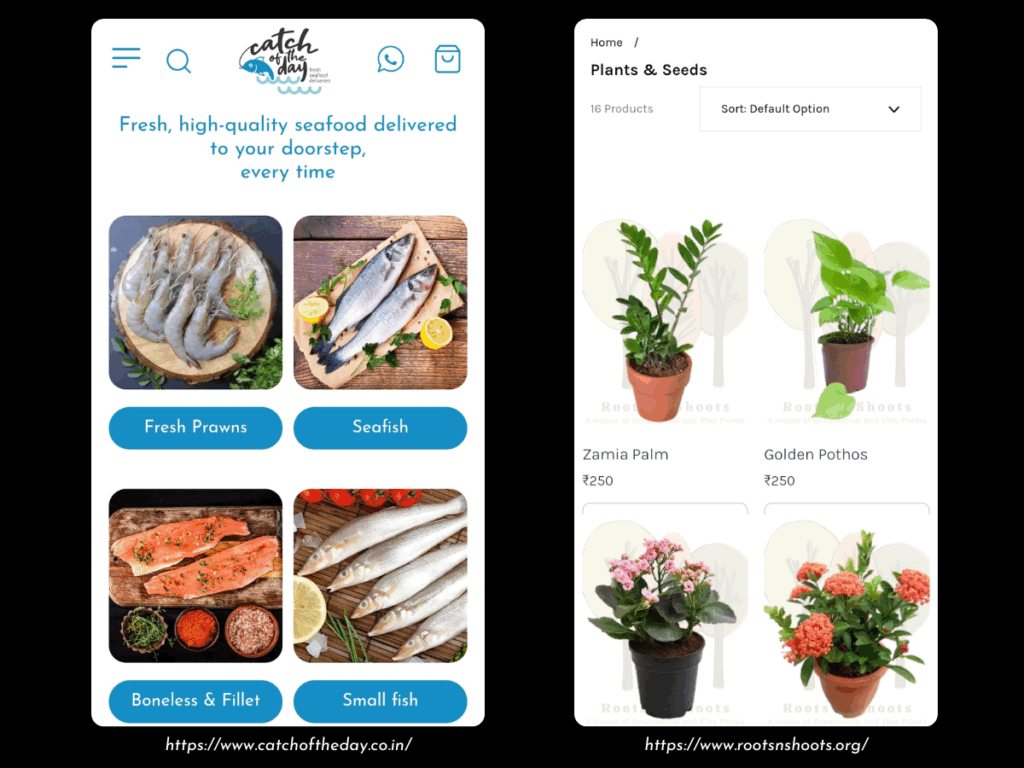
Ensure that you have high-resolution images, videos, 360-degree views, detailed descriptions and customer reviews on your ecommerce website.
5. Offer Streamlined Checkout
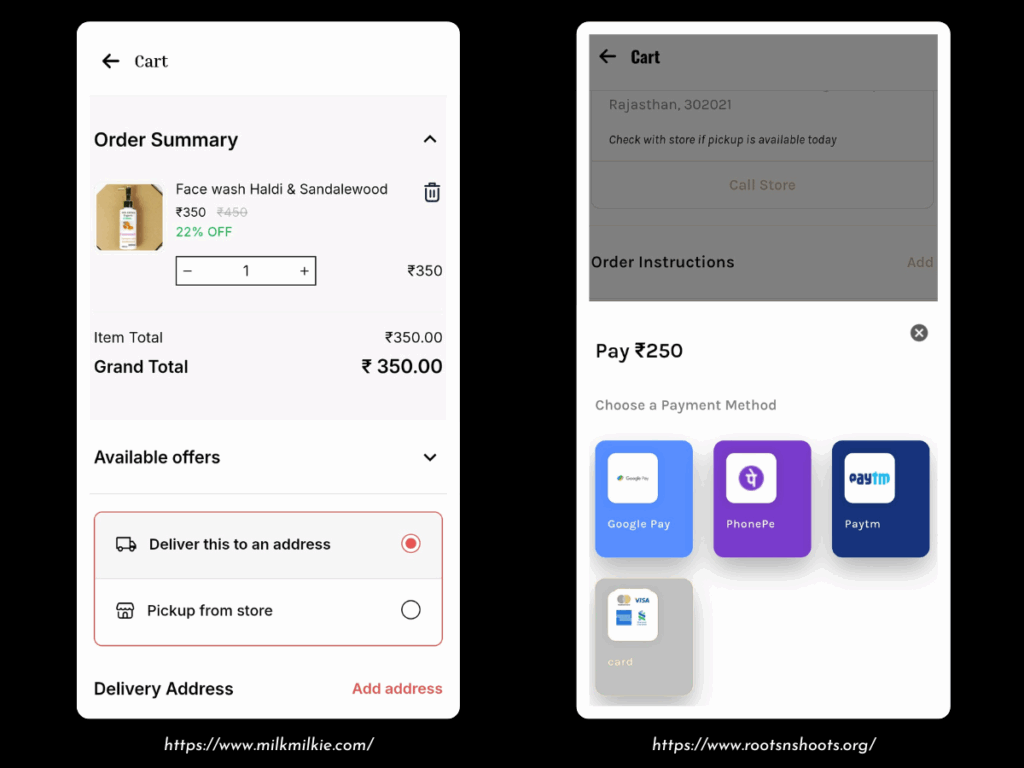
Reduce transaction-related steps, offer guest checkouts, multiple secure payment options and transparent pricing.
6. Win Customer’s Trust
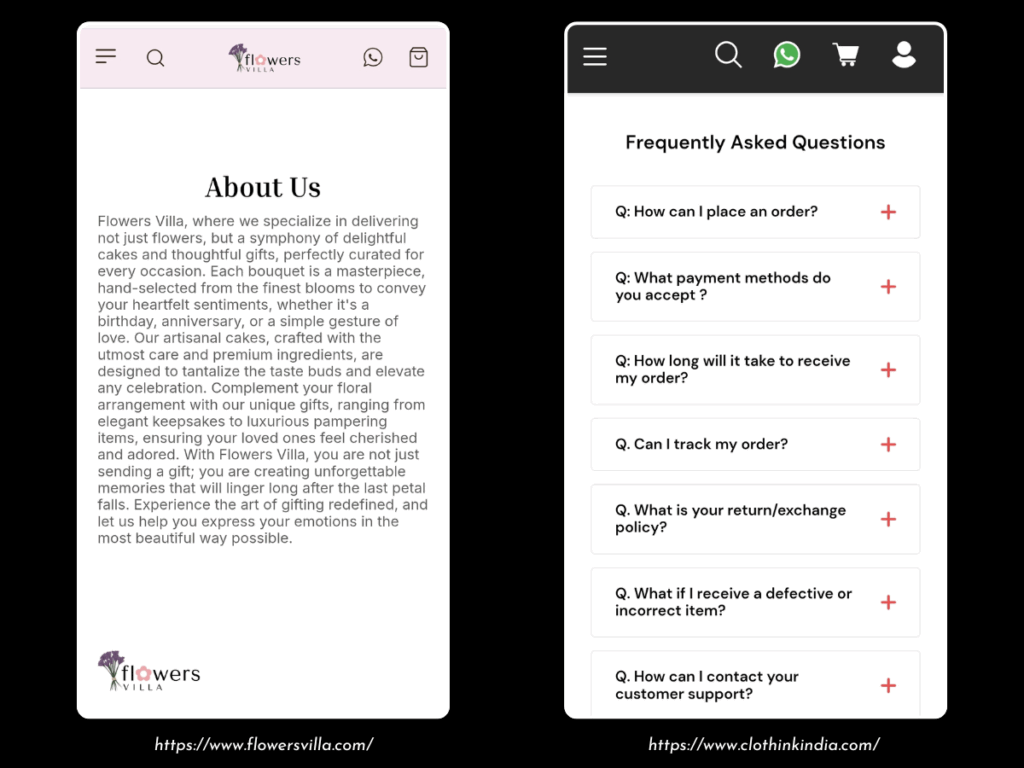
Add clear Contact Info, About Us, Privacy Policies, testimonials, professional design, SSL certificate, etc., to create a comfortable user experience and build credibility.
7. Defined Visual Hierarchy
Ensure clear headings, adequate white space, consistent branding, and incorporate prominent CTAs for a better customer experience.
8. Showcase Channel Integration
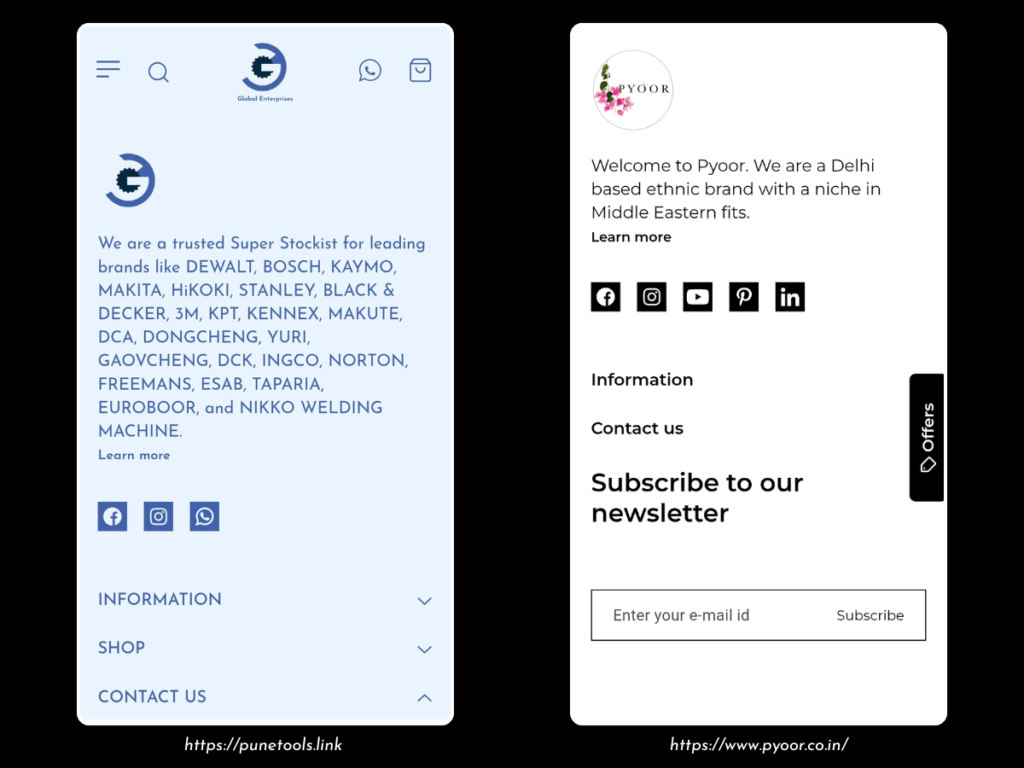
Credibility is what will bring customer loyalty, so connect your social media to the website to ensure omnichannel branding and consistency.
Now that we’ve covered ecommerce website design best practices, let’s explore the must-have features that will enhance your site’s performance and user experience.
Must-Have Features for a High-Performing Ecommerce Website
Every successful ecommerce website runs on a strong foundation of essential features that drive performance. As highlighted in the previous sections, every element, from intuitive navigation to secure payment systems, plays a crucial role in ensuring a seamless and efficient shopping experience.
In 2025, the bar is higher—shoppers expect efficiency, speed, and functionality across every touchpoint. Here’s a breakdown of the must-have features that define high-performing ecommerce stores today:
1. SEO Friendly
Smart SEO helps your ecommerce store rank higher on Google and other search engines. By optimizing everything from meta tags to schema, these platforms ensure your products are easily found by shoppers. Organic traffic remains one of the most cost-effective acquisition channels in India.
Website builders like Digital Showroom offer native SEO features like Meta title & description editing, Mobile-optimised themes, Google Analytics, Tag Manager, Facebook Pixel integration, Sitemap generation, Structured Data (Schema Markup), Customisable Canonical Tags, Optimised robots.txt file, and much more.
2. Product Filters and Smart Sorting
Whether it’s price, popularity, or customer reviews, filtering and sorting tools simplify product discovery. Indian shoppers appreciate control over browsing—helping them find relevant products faster, especially when catalog sizes run into hundreds or thousands.
3. Instant Customer Support (WhatsApp, Live Chat)
With WhatsApp deeply integrated into the daily lives of Indian consumers, offering real-time support via chat builds immediate trust. Tools like Intercom or native WhatsApp chatbots reduce friction and solve queries on the spot—boosting buyer confidence and sales.
4. Verified Reviews and Ratings
Shoppers today rely heavily on peer recommendations. Verified customer reviews act as authentic social proof, helping users assess quality, reliability, and value. Highlighting genuine feedback boosts both trust and conversion rates.
Ensure that you include both text and multimedia reviews—where customers can share images, videos, and personal experiences—to build trust, enhance credibility, and influence purchase decisions.
5. Multilingual Interface
India is multilingual, and so should your ecommerce website be. Offering regional language options breaks down barriers, expands accessibility, and improves engagement among non-English speaking users.
6. ‘Wishlist’ and ‘Save for Later’
Customer centric options like ‘Wishlist and ‘Save for Later’ help users track products they’re interested in but not ready to buy yet. They are particularly useful for mobile-first Indian users who often browse during commutes and return to purchase later.
7. Push Notification Capabilities
Personalised push alerts allow ecommerce websites to re-engage users with updates on new products, flash sales, and cart reminders—particularly effective on smartphones, which dominate online access in India.
8. Cart Abandonment Recovery
Automatically triggering reminders (with or without offers) helps pull users back into the funnel. Given the high rate of cart abandonment in Indian ecommerce, this one feature alone can recover significant lost revenue.
Now that you have understood the must-have features for a high performing ecommerce website, we can go on to understand how you can incorporate SEO into your website and drive organic traffic and sales.
SEO for Ecommerce Websites
For digital businesses, driving sales would involve making the products listed on their website easily discoverable by search engines. This process, known as ecommerce SEO, focuses on optimising your digital storefront for relevant customer searches.
A strong SEO strategy ensures that when potential buyers look for what you offer online, your website appears prominently in the search results. This involves a comprehensive approach to keywords, website structure, content, and online presence, ultimately leading to increased traffic and conversions.
You need to incorporate those specific keywords into the SEO strategy for an ecommerce website in 2025 to rank and scale your business. Here’s how to weave them into the previously outlined points:
1. Keyword Research & Strategy (Incorporating Provided Keywords)
- Primary Keyword Focus
Base your overall strategy around the primary keyword. Say, your primary keyword is ‘ecommerce website’. Your goal is to rank highly for this broad term through consistent off-page and on-page SEO efforts (explained further below). - Leveraging High-Volume Secondary Keywords
Identify the significance of ‘ecommerce’, ‘ecommerce business’, and similar keywords that have a high search volume. Target this keyword in broader content, category pages, and potentially blog posts. - Capitalizing on Emerging Trends
Trends like ‘social ecommerce’ will help you rank especially if you already actively engage in selling through social media. You can search your business category in Google Trends to see all the relevant trends.
All you need to do is create dedicated content or sections highlighting your ‘social ecommerce’ strategies and benefits. This keyword can also be targeted in blog posts discussing the future of online sales. You can also feature trending products in your catalogue to attract high-intent shoppers and boost conversions. - Addressing User Intent
Research and understand the search intent behind the keyword, say the keyword is ‘best ecommerce websites’. This likely indicates users looking for examples, inspiration, or comparisons. You can create blog posts showcasing successful ecommerce websites in your niche or offering insights into what makes a ‘best ecommerce websites’.
2. On-Page Optimization (Keyword Integration)
- Titles & Meta Descriptions
Start by naturally incorporating the primary and relevant secondary keywords into your page titles, content tags and meta descriptions. For example, a blog title could be “Ecommerce Website Design & Development – Your Online B2C Commerce Solution.” - Product Descriptions
Weave in relevant keywords like ‘ecommerce store’ or specific product-related terms. For example, “Browse our wide selection in our ecommerce shop.” - URL Structures:
Use keywords where appropriate in your URLs (e.g., if domain name is your keyword then the URL can be https://digitalshowroom.in/blog/2025/03/05/find-perfect-domain-name-for-your-business/). - Content Integration
Naturally include the keywords throughout your website content, blog posts, and category descriptions. Make sure you’re NOT stuffing keywords randomly and actually focusing on providing valuable information.
3. Content Marketing (Keyword Focus)
- Blog Strategy
- Content Curation: Develop blog content that targets the secondary keywords. For example, if your secondary keyword is ‘social ecommerce’, then you can write a blog on “The Rise of Social Ecommerce”.
- SEO: Link back to ecommerce pillars, marketplace strategy blogs, and relevant content to create topical authority.
- Content Curation: Develop blog content that targets the secondary keywords. For example, if your secondary keyword is ‘social ecommerce’, then you can write a blog on “The Rise of Social Ecommerce”.
- Content Distribution Channels
- LinkedIn Thought Leadership Posts: Repurpose stats and key takeaways in the field of Social Commerce.
- Instagram Reels + Carousels: Turn “The Rise of Social Ecommerce” blog tips into swipeable, shareable content.
- YouTube Shorts: 60-second explainers on “What is Social Ecommerce?” or “Top 3 platforms for Social Ecommerce.”
- Newsletter Feature: Repurpose into a “Social Ecommerce Deep Dive” for your email list.
- Reddit Threads + Quora Answers: Address real user queries with blog snippets + link backs.
- LinkedIn Thought Leadership Posts: Repurpose stats and key takeaways in the field of Social Commerce.
4. Off-Page SEO & Link Building (Keyword Relevance)
When building backlinks, aim for opportunities on websites relevant to ‘ecommerce’, ‘ecommerce business’, or your specific niche (say, if targeting b2b ecommerce’ or ‘b2c ecommerce’).
Understanding the specific terms potential customers use when searching is crucial. Your SEO plan must thoughtfully weave these keywords into your website’s text, organisation, and external promotions.
The goal is to draw in pertinent, organic visitors and enhance your position in search engine results for these key phrases. Always focus on creating helpful, user-centric content where these keywords are integrated naturally and meaningfully.
Now that you have a solid understanding of ecommerce website SEO, let’s dive into some top ecommerce website examples that can inspire your design and strategy.
Top Ecommerce Website Examples for Inspiration
We knew that you would be looking for some samples of what a fantastic website looks like. As a matter of fact, benchmarking top performers is a strategic shortcut to building any great business.
Here are standout examples across business models, industries, and user experiences:
1. Nykaa – Beauty & Personal Care (B2C Ecommerce)
- Why it stands out: Smart use of filters, influencer-driven UGC, fast mobile UX.
- SEO takeaway: Strong product categorisation and optimised meta tags for thousands of SKUs.
2. Lenskart – Eyewear (Omnichannel B2C)
- Why it stands out: Virtual try-on features, AI-backed recommendations, and omnichannel integration.
- Conversion driver: Seamless checkout UX paired with trust signals like “100% genuine.”
3. TataCliq – Fashion & Electronics (Hybrid B2C + B2B)
- Why it stands out: Curated luxury collections, easy returns, multilingual interface.
- B2B element: Offers corporate and reseller purchase options.
4. BoAt Lifestyle – Audio Tech (DTC Ecommerce)
- Why it stands out: Mobile-optimised design, limited releases, influencer collaborations.
- Retention play: Gamified loyalty programs and app-based upsells.
5. Meesho – Social Ecommerce (Reseller-based B2C)
- Why it stands out: Seller-centric UI, WhatsApp-integrated ordering, zero-inventory model.
- Unique angle: Taps into Tier 2 & 3 audiences via vernacular language UX.
Special Tip: Don’t just copy the aesthetics. Dissect their UX patterns, mobile navigation, CTA placements, and SEO structure. Then, apply what fits your ecommerce business model.
Final Thoughts: Building a Future-Proof Ecommerce Website
Your ecommerce website is your brand’s digital flagship. As ecommerce continues to evolve, businesses must shift from static online stores to dynamic ecosystems that engage, convert, and retain.
A high-performing ecommerce website today isn’t just about tech or aesthetics—it’s about creating frictionless experiences that respond to real user behaviours. From lightning-fast checkout flows to AI-powered recommendations, brands that prioritise function with purpose will lead the digital marketplace.
Sustainable growth comes from consistent optimisation. Whether you’re scaling B2C ecommerce or B2B ecommerce operations, success lies in data-backed decisions and customer-driven features. Keep testing, refining, and adapting. And if you’re serious about taking your ecommerce business to the next level, now is the time to invest in strategies that deliver results—not just traffic.
In 2025, it’s not about just being online—it’s about owning the experience.
Here’s your TL;DR checklist:
- Pick a platform that matches your business model
- Master UX, SEO, and social commerce from day one
- Use data to refine, personalise, and automate
- Be mobile, be fast, be authentic
Have fun creating your own ecommerce website in 2025!
Ecommerce Website FAQs
1. How to make an ecommerce website?
To create an e-commerce website, start by selecting a reliable platform, such as Digital Showroom. Then, choose a domain name, design your storefront, list products with detailed descriptions, set up payment gateways, and ensure smooth navigation and mobile responsiveness.
2. What are the 4 types of e-commerce?
Here the four major types of ecommerce business models:
1. B2C Ecommerce
Business-to-Consumer (B2C) commerce or B2C means that the business is offering products or services directly to individual consumers for personal use. B2C ecommerce brands may choose to sell through their online stores or partner with third-party channels such as retailers, wholesalers, or large marketplaces like Amazon to reach their target audience.
2. B2B Ecommerce
B2B (Business-to-Business) commerce refers to transactions where one business sells products or services to another business or organization. It’s important to note that not every B2B company needs a full-fledged ecommerce platform. In many cases, a straightforward website focused on lead generation is sufficient to support their sales objectives.
3. D2C Ecommerce
Direct-to-Consumer (D2C) commerce is a model where brands deliver their products straight to the customer, cutting out middlemen like wholesalers, distributors, or retail partners. This approach gives businesses greater control over pricing, branding, and the overall customer experience.
4. Social Ecommerce
Social ecommerce is the integration of online shopping within social media platforms, allowing users to discover, browse, and purchase products without leaving the app. It merges social interaction with transactional functionality, making shopping a natural part of the social experience.
